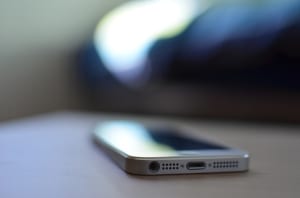During last week’s events in Tampa – Biometrics UnPlugged and the Global Identity Summit (GIS) – one of the talking points that kept coming up during presentations and panels what the growing sentiment that in identity management there is no one solution to fit every problem. There exists a nuance to biometric deployments that has as much to do with security and convenience as it does with culture and context. The future, many are starting to accept, will be multi-modal.
With Mobile Biometrics Month still upon us it’s time to take a look at the many modalities that can go wherever we go with our devices.
Fingerprint

This is the easy one right now. Even though fingerprint sensors have been on mobile devices since 1995 when Digital Biometrics, Inc. was commissioned by Harris Corporation to develop the Squad Car Identification Device (SQUID) for a law enforcement pilot. Now, almost 20 years later, the most widely popular deployments of mobile fingerprint biometric technology have turned from identifying wanted persons to replacing passwords on smartphones and enabling online an point of sale payment.
That’s not to say that fingerprints and mobility aren’t still prominently in the verticals. Just last week, Cross Match Technologies introduced the Verifier Sentry: a mobile fingerprint and credential reader that boasts remote identifying capabilities.
Voice
During a Global Identity Summit panel on the topic of biometrics and mobile commerce, AGNITiO CEO Emilio Martinez expressed his company’s stance on voice biometrics in the mobile biometric ecosystem.
“We believe that the future is in multi-factor authentication,” sad Martinez during his presentation, “We try to fit Voice iD where it makes sense.”
The fact of the matter, when it comes to smartphones, is that they are still phones and despite the growing number ways we communicate using text and visual media they are still designed with the voice in mind. Leveraging the microphone in a mobile device to authenticate through voiceprint has a number of situational benefits: it’s contactless, handsfree and invisible. When smartwatches and wearable devices start to become mainstream technology, voice biometrics stand to offer strong mobile authentication on a device that is too small for many other forms of identity verification.
Eyeprint
The eyeprint is a relatively new biometric modality that relies on measuring the vascular patterns in a user’s eye. Kansas City startup EyeVerify pioneered the technology and has gained a lot of high profile partners including Wells Fargo, Sprint, Qihoo 360 and Samsung Electronics (according to a release published on the Wall Street Journal).
Another highly accessible biometric modality, eyeprints can be captured on any device with EyeVerify’s software and a front facing camera. It’s also extremely frictionless.This year in Tampa at the company’s booth at GIS, the company’s chief scientist, Reza Derakshani, demonstrated EyeVerify positively authenticating him while he was still wearing glasses.
Vital Biometrics
Vital biometrics have a great many uses in mobile tech. the measurement of heart rates, blood oxygen levels and user motion has been used in the fitness technology market for a very long time to help users optimize their workouts. The function used to be exclusively on the wrist, but now companies are exploring how that functionality can be applied to headphones.
In the healthcare industry, vital biometrics and mobility are allowing for new innovations in remote patient monitoring, allowing doctors and clinicians to provide care even to the recently discharged.
Heartbeats are also on their way to the authentication space. Bionym’s Nymi wristband authenticates a user once when she puts it on by measuring the unique characteristics of her heart and then acts as a proximity based factor until its taken off.
Face
Like voice and eyeprints, facial recognition solutions can be used to authenticate on current generation devices without the need for new sensors. With face biometrics, however, the applications go beyond authentication and spill into the world of identification.
The best example of this is how FacialNetwork combines biometrics and the Google Glass. Initially made famous when the company’s “Name Tag” app moved Senator Al Franken to write a three page letter outlining his privacy concerns in regards to this technology, FacialNetwork has a long list of potential uses for mobile face biometrics.
Delivery ID, for instance, allows for an increased level of assurance in online shopping. Upon product delivery, the agent snaps a picture of the recipients face to be matched with a profile in order to authorize the drop off. Healthcare ID offers access control to electronic health records, while LoyaltyID singles out valued patrons in retail situations for better customer service.
Possibly the most unique application suggested by FacialNetwork is ReminderID: a solution used to aid users with prosopagnosia, otherwise known as face blindness.
*
These are only five examples that outline the diversity in mobile biometrics. Let us know your favorite or suggest another by contacting us on Twitter and using the hashtag #FBMobileMonth.
—
September 24, 2014 – by Peter B. Counter


Follow Us